Many of the guns I have purchased have been done so with the idea of being the “last rifle” or “last pistol” I’ll ever need to buy. Of course this never actually works out in practice – something new comes along and I catch the bug. Once in a while, though, I find something that is pretty much perfect as-is, and it endures. An example of this phenomenon: the venerable Smith & Wesson 686. It is my One if I could have only one, my hell or high-water sixgun, my “gun to ride the river with.”
Smith & Wesson 686
The 4″ Smith & Wesson 686 is the revolver that captured my imagination more than any other as a kid. Because I didn’t handle many actual revolvers as a kid, my fascination was merely due to the aesthetics of the thing. And I admit that to this day, no other revolver comes close to achieving the perfectly balanced look of the 4″ 686 (except maybe the 3″ and 5″ 686s…which still only come close). But calling a revolver perfect based on looks alone could responsibly be characterized as irresponsible. So why do I consider the S&W 686 to be the perfect revolver (and maybe even the perfect handgun)?
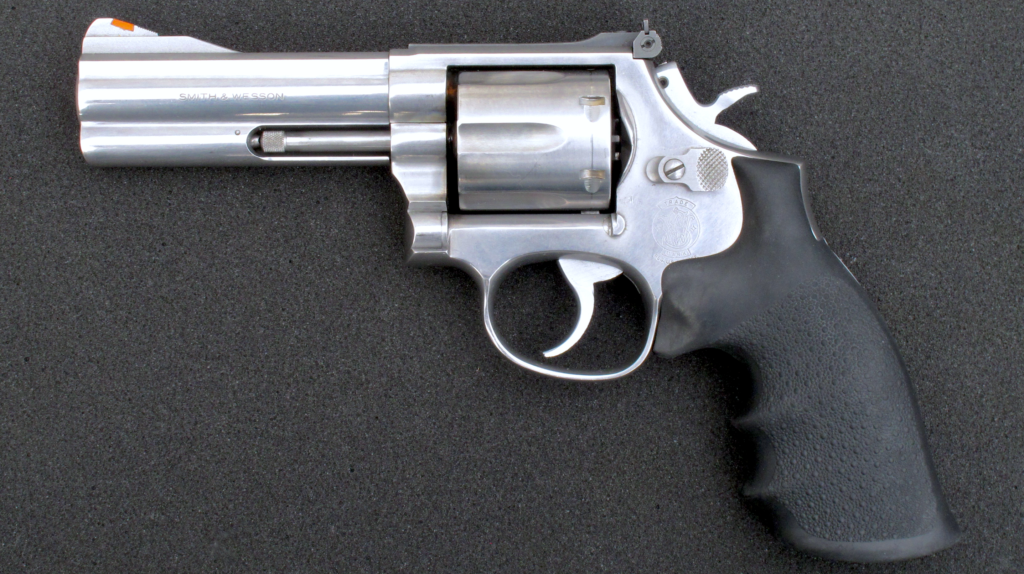
It’s made to shoot. The 686 is built on the L-Frame, Smith & Wesson’s medium-large revolver chassis. The L-Frame was designed to correct the weaknesses of the smaller, lighter K-Frame with a thicker top strap and heavier forcing cone, while keeping the grip the same size. A few other dimensions in the gun were increased, resulting in a revolver that is designed for hard use with full-power .357 Magnum ammo.
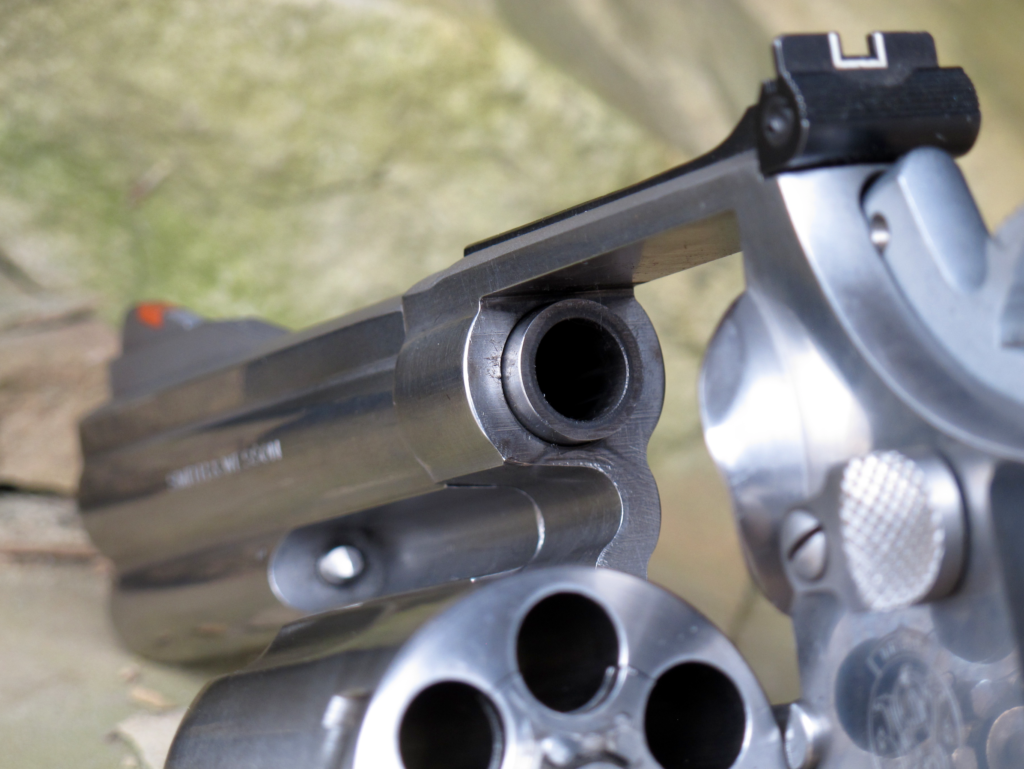
The mid-large dimensions of the L-Frame make the 686 heavy. This is not the worst thing. First, it soaks up recoil like a sponge. You can run the gun hard and run it fast. You can shoot any SAAMI-spec’d .357 Magnum load available, and do so with a smile on your face. The heft of this wheelgun also lends some stability when more precision is desired. In competent hands, a revolver of this size can be counted on to ring steel reliably at 100 yards or more. It is likely that it could also make an ill-intentioned rifleman of mediocre skill downright uncomfortable at similar remove.
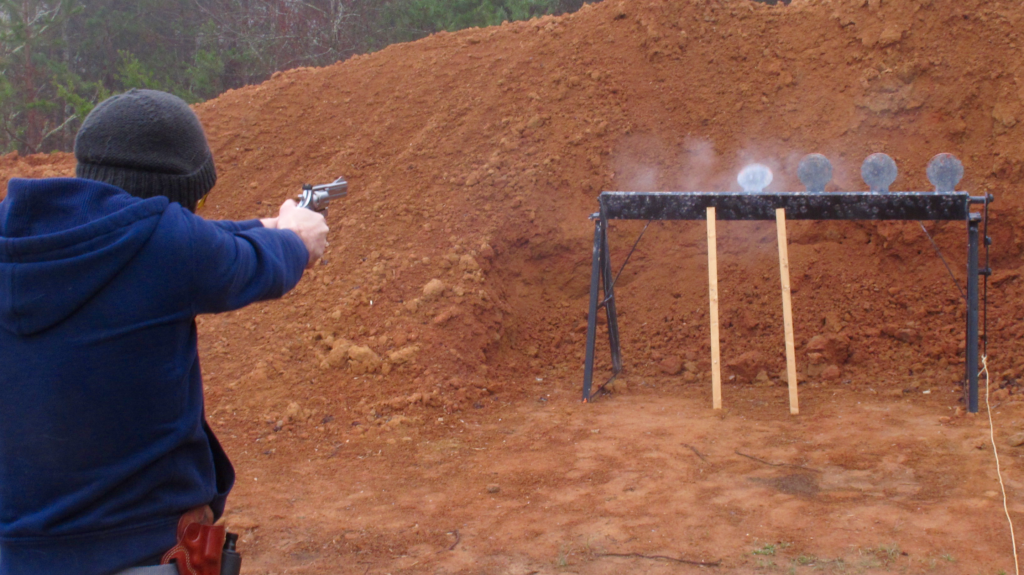
It doesn’t need modification. I have toyed with the idea of lightly customizing this revolver. But I’ve reached the conclusion that S&W pretty much did it right when they made this one. The double-action trigger is one of the smoothest and cleanest I’ve ever seen, breaking right around an even 10 lbs. Even the Hogue Monogrip that no one else likes just works for me, though I have replaced it with VZ Grips’ Tactical Diamonds.
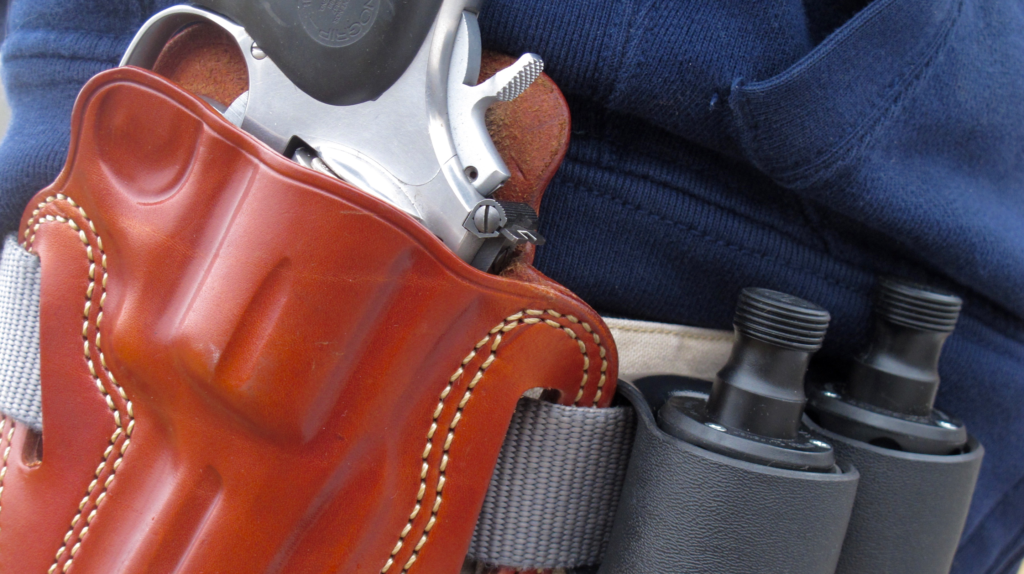 It’s rugged and reliable. It is said that a man to ride the river with is a man that can be counted on in any situation and against any peril. A revolver to ride the river with should live up to the same standard. It should be one that earns and keeps the confidence of its owner, as the 686 has and does. The Smith & Wesson 686 is as reliable a gun as I’ve every carried.
It’s rugged and reliable. It is said that a man to ride the river with is a man that can be counted on in any situation and against any peril. A revolver to ride the river with should live up to the same standard. It should be one that earns and keeps the confidence of its owner, as the 686 has and does. The Smith & Wesson 686 is as reliable a gun as I’ve every carried.
The one facet of this revolver that I have contemplated changing is the rear sight. As my “hell or high-water” sixgun, this revolver is expected to accomplish its task regardless of difficulty. The factory adjustable sights are the most visible weak link in this gun if there is one. Possible replacement candidates are the Bowen Rough Country adjustable rear sight or the D&L Sports fixed rear sight, but I have not yet committed to either. I like the idea of both, but each has a disadvantage. The Bowen cuts a slighter higher, sharper profile, and the D&L would require the gun be permanently sighted in with a specific load (probably 125-grain Speer Gold Dots).
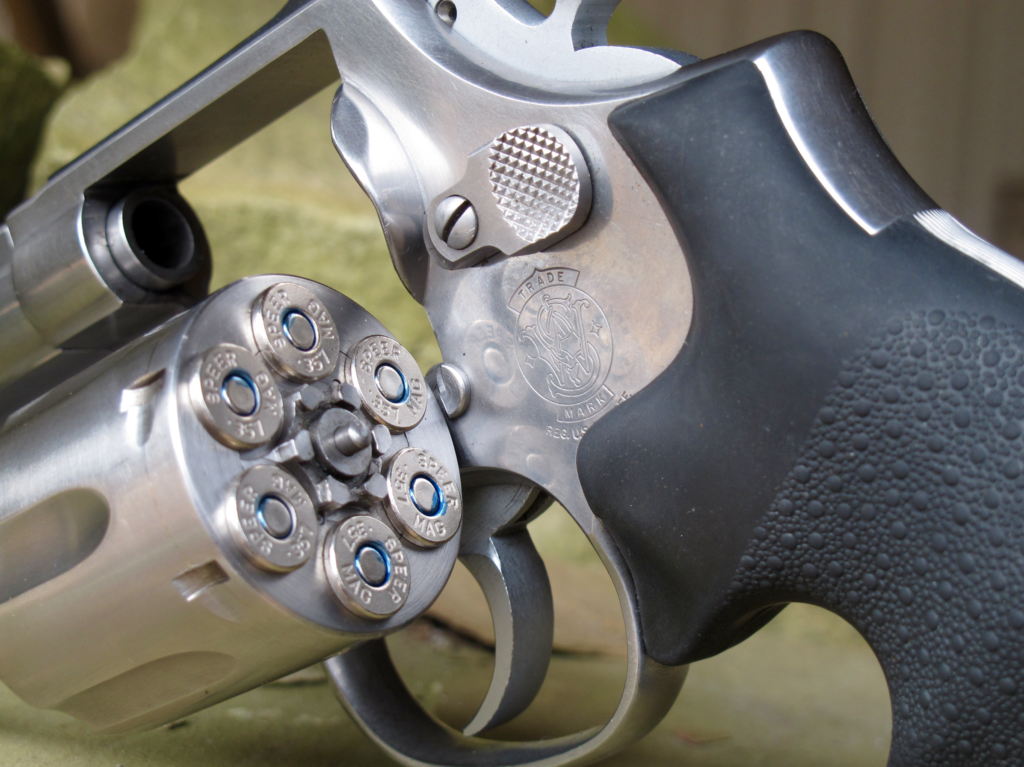
It’s versatile. This is perhaps the most compelling reason that the 686 would be the one, if I could only have one. It’s also my go-to gun for outdoor carry. Although it gets a little heavy for all-day carry, it can be carried. Though it’s a little large for concealment, it can be concealed. Though it’s a little light for predator defense, it works. Appropriately loaded for the task at hand, the 686 will do what needs to be done. It’s the minimalist’s gun: a generalist in the extreme.
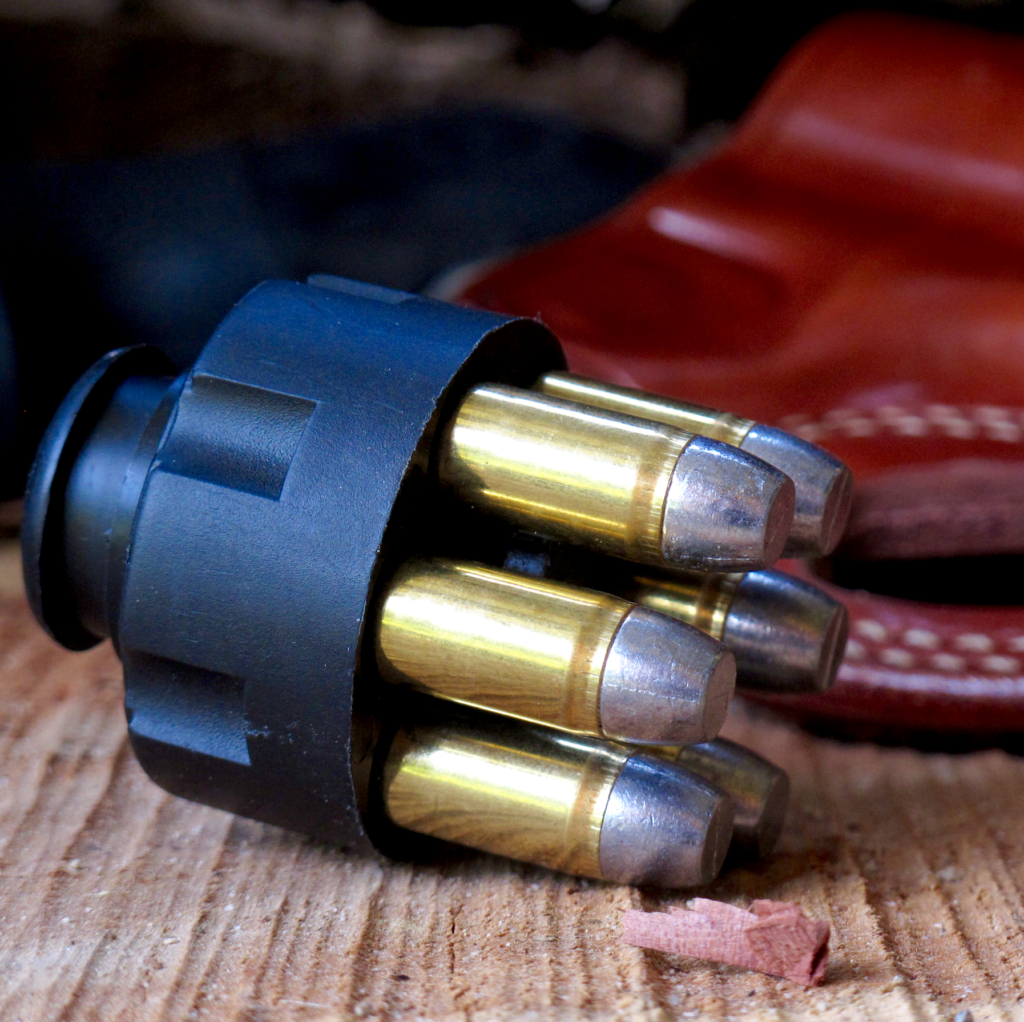
As I stated earlier, if I could have only one, this would be The One. The 686 is classy, rugged and reliable, and above all, versatile. So let me hear from you: what is your “gun to ride the river with”?

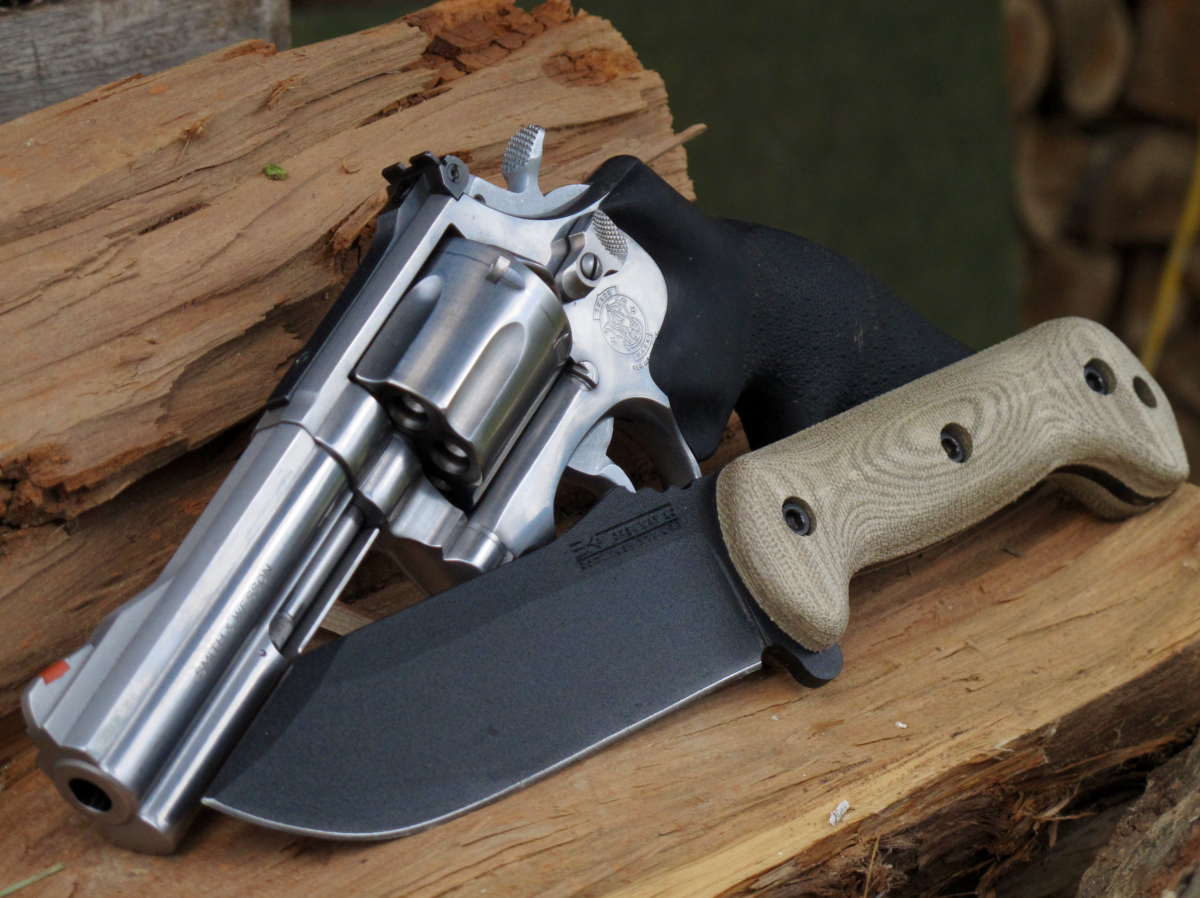
The 686 is never a bad choice, having owned several I can understand the allure.
Personally I always found the full underlug too much of a good thing (mass) and ended up going back to either a 4″ Model 57 .41 Magnum or a 629 Mountain Gun, both pre-lock/MIM, for carry and trail use.
Funny thing, I did the exact opposite and got rid of all my wheel guns, settling instead on a Colt Gold Cup for most things and a Glock 23 for concealed carry and teaching classes.
Won’t say that my choices are the best, but just like your choice of wheel guns, it’s our choice.
It’s hard to argue with the allure of Glocks. They’re cheap, they work, and you can have one (or two or three) in just about any caliber you fancy. I’ve been eyeing a Mountain Gun for awhile, but I never got into the .41 Magnum…at least not yet.
Oh Buddy!
If the 686 is perfect (or damn close to it) the only thing that could make me rethink it would be the same gun in .41 Mag. Unlike the “.44″‘s -with a bore diameter of .429 – the .41 is pure ; .410. great cartridge.
Came over here from SOFREP to read the whole piece.
Love those Buffalo Bore hardcasts.
A mod I’ve made to two of my carry Smiths (a 2” Mod 64 and my 686) was to have my smith take a goodly bit of the front of the trigger down. Shooting with gloves on, I found the trigger wouldn’t reset; the glove got caught between the front of the trigger and the frame. The trigger is now almost perpendicular to the beginning of the finger curve and I have no reset problems while wearing gloves.
I use Bianchi leather from Frontier Gunleather ( the old Bianchi “Cyclone”) and have custom walnut “Clint Smith Style” grips from Blu Magnum. Still got the Hogues if I need to put ’em back on.
My 686 was the first pistol I bought. Still have it and shoot it quite often. I wish I would have bought the 4″ barrel, but the 6″ barrel is pretty sweet ! From shooting target .38 Special loads or full power .357’s the 686 does it all !
Mine was a spur of the moment decision, and one of the best firearms decisions I’ve ever made. I’ll never let it go!
I too am chiefly a revolver guy but usually it’s a Ruger SP 101 or GP100. I don’t have your credentials but choose a revolver for most of the same reasons. However, a 1911 in .45 is in my carry rotation too.
I completely agree with this article, only I prefer the 3″ barrel to the 4″ barrel. This does not mean much though seeing as I have owned neither.
I definitely don’t think you’d go wrong with a 3″ 686. I think they look great, pack a little easier, and still shoot wonderfully.
Last year I bought a 3 inch 686 plus. I feel the same way you do, will never sell it. I carry it in a Galco holster made for a 4 inch. Started to send it back since I ordered a 3 inch, but never know, I might end up with a 4 inch one of these days. Great job writing about the 686!
Bob
I’m a Smith guy through and through but the title of this article caught my attention because it’s exactly how I describe my blued, Ruger Wiley Clapp GP100.
Someone has been reading Askins and Jordan! Don’t know your age, but you are younger than me because I remember the 686 as a young adult. Yeah, it looked cool, but why the extra weight over a 66? That was before I understood the ::weeping:: weakness of the K-frame to stand up to a steady intake of full-power magnums.
If you want great balance, out of something longer than a 3″ revolver, hunt down a 686+ with a 5″ barrel, sans under lug – don’t know the value of them these days, but let’s just say it’s worth it.
Just discovered your site and am enjoying the articles. Keep posting – I added it to my bookmarks.
David,
Glad you’re enjoying it! I was talking with Mike Wood earlier today and we both agreed – the Wiley Clapp GP100 is a fine wheelgun. I might have to track one down one of these days. I also like the 5″ 686 – a close friend has one (with unfluted cylinder) and I really like it.
Thanks again,
Justin
“Same gun,” meaning L-frame
size, for me but in the
design of the GP-100 from Ruger.
I’ve shot Smiths for decades but
in recent years I’ve turned to
the GP-100. As to barrel
length, I’m happy with 4 inches
but I also like the 3-inch version.
In a day or so I’ll have the new
7-shot version with 4-inch bbl.
After decades of using
Smith revolvers including
the 686, I now use mostly
a GP-100 in 4-inch and 3-inch.
The GP is Ruger’s L-frame and
I just love the ruggedness of them.
Soon I’ll have a new 7-shot
version in 4 inch.
Dan – If by “ruggedness” you are referring to Ruger’s alleged superior strength over other brands…this may be a myth. I used to think my S&W’s were weaker than Rugers. I recently learned about the differences between cast frames vs. forged. I think Ruger’s single action Blackhawk frame is indeed strong…as many custom makers re-build them for the powerful Linebaugh series of cartridges…but when it comes to DA revolvers, a lot of people assume Ruger’s are stronger because they have bulkier frames. Because Ruger frames are cast, and not forged, they need to be larger to maintain the same level of strength.
Brian and Dan,
Stay tuned, guys – we have something planned for late-Jan/early-Feb that you guys will love!
Justin
Brian, you are exactly correct as to the strength of the 686. Forged frames can be made less hefty than cast frames and have equal or greater strength than cast frames. It’s just a matter of choice of construction. I prefer the sleeker look of the Smith & Wesson forged frames.
Dave, we did a rather extensive two-part series on that! See the “Frame Wars” articles, especially Part II:
https://revolverguy.com/great-revolver-frame-war-part/
https://revolverguy.com/great-revolver-frame-war-part-ii/
My first, and only foray into wheel guns so far, is an early 4″ 686-4 (last of the all MIA). It’s made a believer out of me. I’d rather shoot it over my 17 rd S&W 9mm, my daily carry Walther compact 9mm, my mouse gun 380 acp. The only pistol I like to shoot more is my Springfield 1911. But, as the author said, there is just something about the aesthetics of the 686. It’s a siren song. In a 2 handed grip, it is perfectly balanced.
I currently own only four S&W revolvers, & they are all older models, 629/6″, 657/8⅜”, 617/4″, and a 66/6″. I have owned three 686’s down thru the years, & had nothing but problems with them ! Always the same malfunction on every one. When I bought them, I was in awe of the accuracy & actions, but that didn’t last too long for me. The first one I bought a 6″ worked great for about three years, & suddenly started to malfunction in single action shooting. When the trigger was pulled, the hammer would drop of the single action sear, and catch on the double action sear, pushing the trigger forward and your trigger finger along with it. Back to S&W for four weeks. They repaired it and returned it to me. Within three months, it happened again. Back for repair, & I sold it upon getting it back ! A couple years later, I figured they may have corrected the problem, so I bought a new 4″ 686, & within a year it also began to malfunction, same problem ! S&W got it back also. Fixed it & sent it back. Next time it happened, I took it apart, and stoned the sears, & fixed it myself & sold it. I came to the opinion that the chrome plated hammers & triggers were too soft, and caused wear on the sear edges.
Now, next one I looked at much later had black or dark gray triggers & hammers ! Problem solved, right ? Well no, not for me, because by that time I no longer trusted my life to it, & traded for my first GP100, and never looked back !! I would not ever get rid of my older S&W’s for any amount of money, & wouldn’t pay a dollar for a new one, if I had to depend on it to defend my friends or family !!! I truly trust any of my Ruger GP100’s, 4″, 6″, & MC 4″
Jim
Great read! I agree with everything you mentioned. Mind you, I’m a real revolverphile…
I own a Ruger GP100 in 4.2″ which I shot with competitively, as well as a S&W 627-5 which I also shot with competitively in IPSC.
Though admittedly, despite the huge advantage of having 2 extra rounds in a cylinder, the feel and maneuverability of the smaller yet still amply robust L-frame GP100 has me crawling back to it every time. And I think we can all agree that there are far more similarities than differences between the 686 and the GP100
Thanks for this excellent review. Just ordered a 586 L-Comp. If it’s as good as your 686, I’m sure to be pleased!
Thanks for a great review of a great handgun. I have a 686-6+ 3″ and 2 J-frames and I’m always amazed by all of them; but the 686 is the favorite.
Keep up the good work and words.
I have studied thoroughly for a S&W wheel gun and the Ruger 100. Both are very great designs and would proudly own either. After reading your great informative article, I have decided on the S&W 686 3″ barrel. I decided not to go with the Ruger 100 is the rear sight turned me off.
Thanks for the great review, as it tipped the scales for me to go with the 686.
Keep up the great informative articles. I thoroughly enjoyed this piece!
What make are those speed loader holders pictured in front of the holstered 686? Which loaders are those?
Tom, those are the elusive SL Variant speedloaders. You can read about them here:
https://revolverguy.com/mythical-s-l-variant-speed-loader/
This is an excellent review, just the facts we would need to know about Smith & Wesson 686
I recently aquired a 686-3 snub gun. I happened to fall into it while looking for a GP100 5inch. I found both and bought both. To me, Comparing a 686 to a GP100 is like comparing a ham sandwich to a turkey sandwich. Sometimes I’m in the mood for ham, sometimes turkey. Both are well built and worthy of owning…nice review by the way…
Yesterday I bought my first revolver. The L frame 686-6. It is a beauty. 4 inch barrel, quick cylinder release designed for one hand and a larger width hammer. A dream gun.
Welcome to the wonderful world of revolvers! Enjoy!
Good article. The first DA revolver I bought was a 686 from the time they switched to pistols. Sold it a few years later and regretted it dearly. Spent ten years looking for a 586 and found a round butt at a great price. I’ve owned Smiths, Dan Wessons, and Rugers in .357, but will be buried with the 586.
That should be amended to say
From the time law enforcement switched from revolvers to pistols.
I love S&W wheel guns but if it is your ride the river gun, Ruger Super Redhawk Alaskan. Hands down! You shoot a bear with a 357 and it will have you for lunch, 44 or 454 will let you see you’re family again as long as you don’t freeze. But S&W’s are as great as a revolver could possibly be.
I hear you on the Grizzly thing… then again, the evidence would indicate that a bear shot with just about any centerfire pistol will take off.
My “gun to ride the river with” isn’t a “bear defense” gun. It’s a gun for all reasons. It’s a gun that I can afford to practice with (I put about 3,000 rounds of .38/.357 downrange last year). It’s a gun that isn’t painful to practice with. It’s a gun that’s at home on the street – i.e. it can be fired rapidly and accurately and can be carried (even if not perfectly). All of these reasons would contraindicate the .44/.45 calibers…at least for me, in addition to the fact that there isn’t a grizzly bear within 500 miles of me.
I really like my S&W 686-6 Plus (meaning the cylinder carries 7 rounds) Deluxe (meaning rosewood grips) revolver. It shoots straight, is balanced and manages recoil well. Quality in a large caliber revolver, perfect for home defense.
I must say I have agree. I normally vet statements like yours by trying to prove them wrong. In each category even staying with SW manf only I could find a better choices but if you take into account all of them I was forced to admit a 4″ 686 in SS is about the ideal balance.
For cartridge the 38/357 gives the best balance of size cost and performance and availability from plinking to hunting to combat to end of the world. Ideally those would be 22lr, 44mag, 357 or possibly 9mm para. But for one that could do it all the best 357 it is.
For an end of the world revolver in that cartridge I would go with the 8 shot 687 5″ with full moon clips. You have a greater need for capacity. You have the same rounds as the 8rd 1911 gov mags with very close to the same reload speed and many times better reliability from jams and or out of battery situation at H2H distance shooting which is very likely.
Hunting the 44 and larger at various power levels rules the roost but the 357 will handle most everything but the largest game and at decent ranges and recoil. Sure a longer barrel would be best but 4″ is still like a 5″ auto so….
Concealed a snubby lighter frame 3″ but is little good for anything else.
Plinking 22 or a lighter frame 38 spl or 9mm model but then its limited everywhere else.
In terms of aftermarket parts its hard to argue. Staying with revolvers not only is the 686 and L frame in general popular many of the various model’s parts are cross compatible. The grips unlike other models allow for wide variance in hand size.
To work on and being able to see function and to break down the SW is superior to the Ruger . I really like my black/red hawks as well as the gp100 comp. With that said, no side plate access as Ruger needed the added strength because they only investment cast vs forged. That lead to having to drop the trigger group out the bottom and must take grips off etc to remove cylinder just makes things harder and more complex. You also have no visual of how the parts interact a real issue for the home smith.
Thanks for the feedback on this. I hadn’t even thought of that last one – much appreciated!
It has been a year since the last comment. I enjoyed this post while eating lunch at the office. Good job. My favorite hand gun is my 686-6 3″. It is a gun I enjoy simply looking at. With my 686, I always out shoot the other hand guns that I take with me to the range. When I’m out on the river boating, I typically take my 60-14, 2″ so that I won’t sink to the bottom if I have to swim to shore. Other times, on a hike or out of doors, I carry my 686 IWB in an appendix holster.
I own two S&W 686’s one in 6 inch and one in 8 3/8 inch. I prefer the 6 inch. I have one other however that is my favorite and that is the Ruger GP100 6 inch. I started out with the 4 inch Ruger but a friend owned the 6 inch and I could always do better with it than my own so I sold the 4 inch and bought my current 6 inch. I would not want to be put into a position to choose which one to let go, I love them both.
A great article and some great comments.I only held a Ruger revolver once and the trigger was poor,gave me an irrational dislike of all Ruger revolvers.I love Smith and Wesson revolvers,the shoot well and are just so pretty and in proportion to me.
I only own 2 firearms, a Ruger GP 100 4.2 inch 357 magnum and a Glock 20sf 10mm. Im keeping it that way unless they ban Semi auto here in California then I would most likely buy a Ruger Match Champion 10mm. But as a Ride the River Gun with, I would go with the Revolver too. But I really love then 10mm/40 cal combo.
Just found your site linked off the Loadout room. Great article, and comments. Thinking about EDC my 4″ 686, really like the holster pictured with the drop loaders.
Glad you enjoyed it! That’s a Galco Combat Master holster for the 686.
Thanks, I wasn’t sure.
I chose the Ruger SS GP100, 3″ .357 over the 686. Reason? The gun is for off duty concealed carry / hiking (IWB holster) and I don’t like adjustable sights on a trail gun or that damn lock. I have the lock on my SW 29-10 4″ .44, shoots fine, no issues, but I despise the Clinton hole. Ruger has no hole, or adjustable sights to POTENTIALLY get knocked out of alignment. Ruger makes a very rugged gun. I love SW too, but for me, the GP-100 hit soda cans at 20 yards, and the trigger smoothed out considerably after a few thousand dry fires. 3″ barrel in the IWB Bianchi holster is comfortable when driving, unlike many 4″ or 5″ guns.
That’s a great gun, Chris. Standby for our upcoming article on “The Lock”—you’ll find lots to agree with, I think.
To clarify, I put the compact grips on my GP-100, and removed the oversized grips. Even with hot .357’s, recoil is negligible due to the 35 oz weight. It makes for a very handy trail of concealed carry weapon. If I can nail soda cans out to 20 yards or so, offhand, then the arm serves my needs on the trail or off duty. Very accurate with .38 spl 148 wadcutters too. Carry load is 158 SJHP .357 PMC, a smoking little round.
BOY DO WE AGREE!!!!! Have the 4 inch and going to get the three love to shoot the 686, if anybody has not you should, I also have 586 blue but the stainless is so smooth just a fun gun to shoot , can’t go wrong with a 357 it takes care of everything ya need, good read here
Here is a story for you… I acquired the second factory gun, a 686 with 6 inch barrel and factory ivory grips. The fellow I got it from, needed money since he was going thru a divorce. This guy won it in a card game from a factory sales rep. less than a year after the gun was issued. I sold it to a cousin of my wife, and we shared his reloading and shooting adventures. My gun at the time was a Ruger ss Blackhawk with 4 5/8 bbl. The 686 is still in their family.
Could anyone tell me the name of the knife on the cover picture? Thanks
Sure – that’s a Becker BK-10 “Crewman”. Ka-Bar makes a very good version of the BK-10 currently.
I have two safes full of firearms, with a large variety of type, manufacturers, models and calibers (Glock, Cabot, Colt, Cooper, Springfield, Kimber, STI, etc…). In my top 3, is my 2.5 inch 686-1. It is a well made, reliable, solid chunk of steel. The weight of the L frame and the pachmyer grip effectively absorb recoil and make shooting .357 exceptionally manageable. The trigger is almost (I stress almost) as good as my 1972 Colt Python. Double action is not too heavy and it is easy to stage the trigger (if desired). Single breaks with authority, like glass (sorry to be cliche). My 686-1 fits comfortably inside my waist for conceal carry. For a rather large revolver there is no printing.
My 686-1 is a fine revolver and I trust it with my life.
My 686 is a four inch that is about thirty years old. As you said, “if you could only have one” it would be high on my list. I also love the 610 five inch, but being an N frame is a tad larger. – – I’ve only had ONE incident with my 686 and that was from a very heavy hand load. The cylinder “froze” in position after the shot. Turns out the primer had expanded enough to lock things up. (long story short) A hard rap with the heal of my right hand on the cylinder (holding the release open with my left thumb) popped the cylinder out. ZERO problems with the gun. – – Smooth, accurate, FUN to shoot. What more could anyone ask for. 🙂
I am most impressed and entertained by this forum, and particularly this article. I am a revolver guy, and a .357 guy, and a versatile, medium frame size guy.
That has always meant a 4 inch GP100 for me, though I had a 6 inch 686 that I loved almost as much. However, I have recently purchased a 3 inch 686 Plus and I am afraid it has supplanted my GP100 as my favorite firearm, and the last that will leave my hands. It is just about perfect in every respect.
I don’t want it to be any lighter or smaller. I don’t want it to be any heavier or larger. I don’t even need it to have a higher capacity. I am old enough to have carried a 1911A1 in the Army and had only 7 rounds then (we were not allowed to carry one in the chamber). So now I still have 7 rounds with the 686 Plus. I love everything about the 1911, but not quite as much as I love everything about my 686.
Thanks for a great article and a great forum (or is it a blog?- I’m an old man and don’t know the difference)
Thanks Steve, we hope you’ll stick around and enjoy it some more. There’s lots here to see.